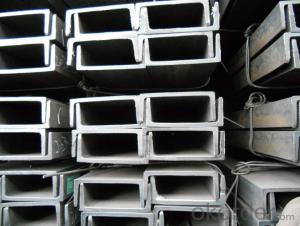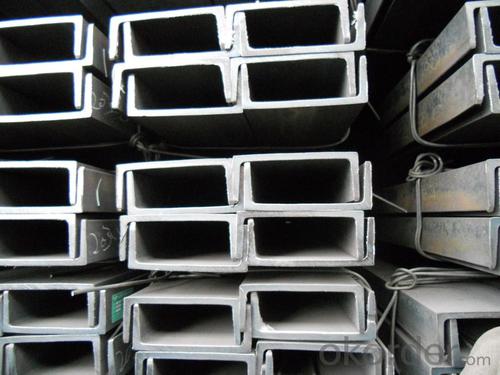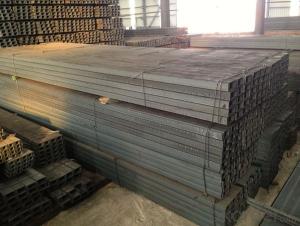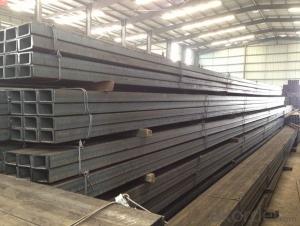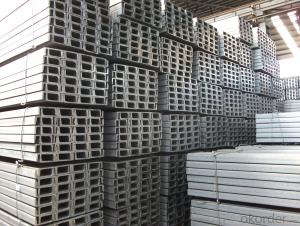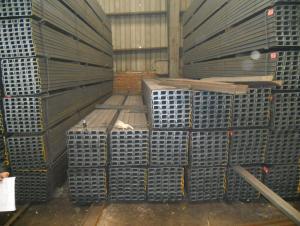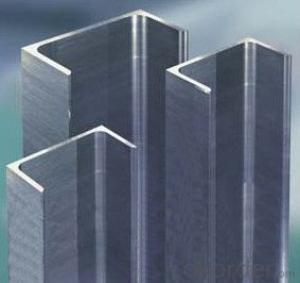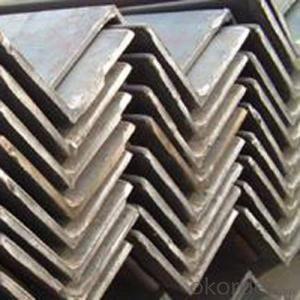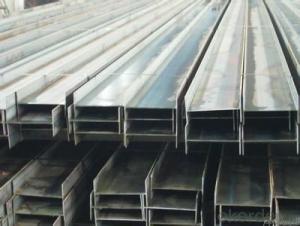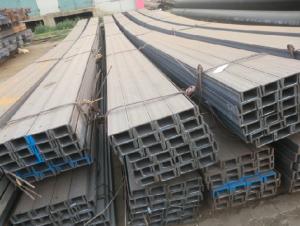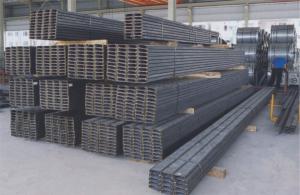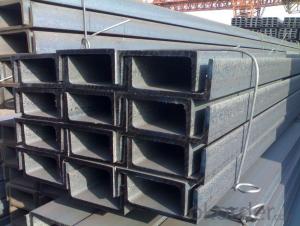Prime Hot Rolled Alloy Steel U Channel
- Loading Port:
- China main port
- Payment Terms:
- TT OR LC
- Min Order Qty:
- 100 m.t.
- Supply Capability:
- 10000 m.t./month
OKorder Service Pledge
OKorder Financial Service
You Might Also Like
Product Description:
OKorder is offering Prime Hot Rolled Alloy Steel U Channel at great prices with worldwide shipping. Our supplier is a world-class manufacturer of steel, with our products utilized the world over. OKorder annually supplies products to African, South American and Asian markets. We provide quotations within 24 hours of receiving an inquiry and guarantee competitive prices.
Product Applications:
Prime Hot Rolled Alloy Steel U Channel are ideal for structural applications and are widely used in the construction of buildings and bridges, and the manufacturing, petrochemical, and transportation industries.
Product Advantages:
OKorder's Prime Hot Rolled Alloy Steel U Channel are durable, strong, and wide variety of sizes.
Main Product Features:
· Premium quality
· Prompt delivery & seaworthy packing (30 days after receiving deposit)
· Can be recycled and reused
· Mill test certification
· Professional Service
· Competitive pricing
Product Specifications:
Manufacture: Hot rolled
Grade: Q195 – 235
Certificates: ISO, SGS, BV, CIQ
Length: 6m – 12m, as per customer request
Packaging: Export packing, nude packing, bundled
| JIS STANDARD CHANNEL | ||||||
| SIZE(MM) | h(mm) | b(mm) | s(mm) | t(mm) | kg/m | length |
| 50x25x3x6 | 50 | 25 | 3 | 6 | 2.37 | 6m,12m |
| 75X40x3.8x7 | 75 | 40 | 3.8 | 7 | 5.3 | 6m,12m |
| 75X40x4x7 | 75 | 40 | 4 | 7 | 5.6 | 6m,12m |
| 75X40x4.5x7 | 75 | 40 | 4.5 | 7 | 5.85 | 6m,12m |
| 75X40x5x7 | 75 | 40 | 5 | 7 | 6.92 | 6m,12m |
| 100X50x3.8x6 | 100 | 50 | 3.8 | 6 | 7.3 | 6m,12m |
| 100X50x4.2x6 | 100 | 50 | 4.2 | 6 | 8.03 | 6m,12m |
| 100X50x4.5x7.5 | 100 | 50 | 4.5 | 7.5 | 8.97 | 6m,12m |
| 100X50x5x7.5 | 100 | 50 | 5 | 7.5 | 9.36 | 6m,12m |
| 125X65x5.2x6.8 | 125 | 65 | 5.2 | 6.8 | 11.66 | 6m,12m |
| 125X65x5.3x6.8 | 125 | 65 | 5.3 | 6.8 | 12.17 | 6m,12m |
| 125X65x5.5x8 | 125 | 65 | 5.5 | 8 | 12.91 | 6m,12m |
| 125X65x6x8 | 125 | 65 | 6 | 8 | 13.4 | 6m,12m |
| 150x75x5.5x7.3 | 150 | 75 | 5.5 | 7.3 | 14.66 | 6m,12m |
| 150x75x5.7x10 | 150 | 75 | 5.7 | 10 | 16.71 | 6m,12m |
| 150x75x6x10 | 150 | 75 | 6 | 10 | 17.9 | 6m,12m |
| 150x75x6.5x10 | 150 | 75 | 6.5 | 10 | 18.6 | 6m,12m |
| 200X80x7.5x11 | 200 | 80 | 7.5 | 11 | 24.6 | 6m,12m |
FAQ:
Q1: How do we guarantee the quality of our products?
A1: We have established an advanced quality management system which conducts strict quality tests at every step, from raw materials to the final product. At the same time, we provide extensive follow-up service assurances as required.
Q2: How soon can we receive the product after purchase?
A2: Within three days of placing an order, we will arrange production. The normal sizes with the normal grade can be produced within one month. The specific shipping date is dependent upon international and government factors, the delivery to international main port about 45-60days.
Q3: what is the difference between actual weight and theoretical weight?
A3: All the section steel has two weights: actual weight and theoretical weight. Actual weight is the weighing out when the product delivered from the mill. Theoretical weight is calculated by pieces. The invoice can be based on each of them as your request.
Images:

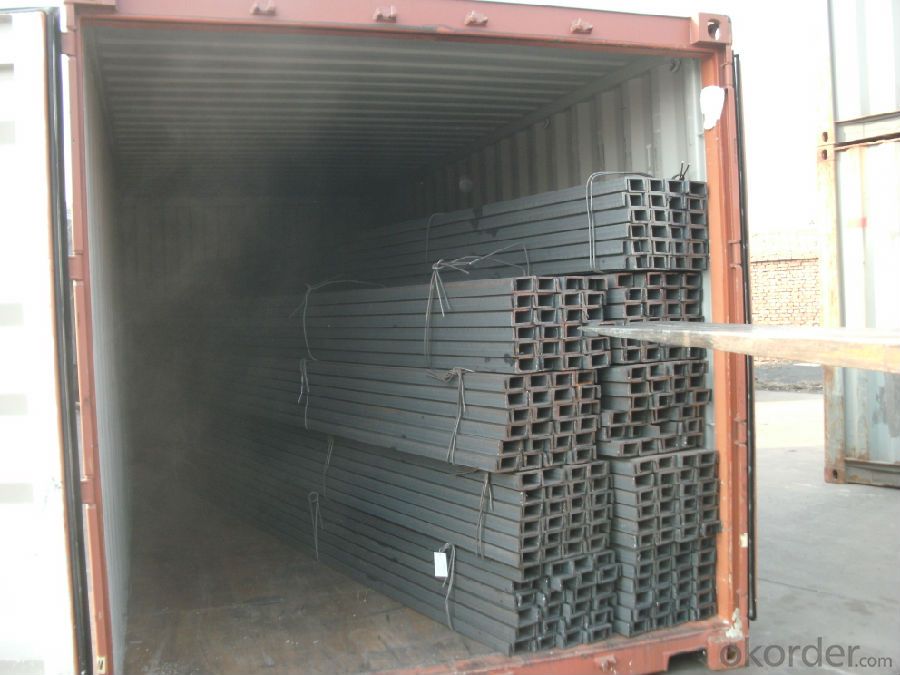
- Q: What is the load-bearing capacity of steel channels?
- The load-bearing capacity of steel channels depends on various factors such as the size and shape of the channel, the grade and quality of the steel used, and the specific application and conditions in which it is being used. Steel channels are commonly used in construction and engineering projects to provide support and structural stability. They are designed to withstand the weight and pressure exerted on them without deforming or collapsing. To determine the load-bearing capacity of a steel channel, engineers typically consider the maximum allowable stress or load that the channel can safely carry without exceeding its yield strength or causing permanent deformation. This is usually determined through rigorous testing and analysis, taking into account the specific properties and dimensions of the channel. It is important to note that load-bearing capacity can vary significantly depending on the specific design and manufacturing processes used for the steel channel. Therefore, it is crucial to consult engineering specifications, codes, and standards, or seek the guidance of a professional engineer to accurately determine the load-bearing capacity of a specific steel channel for a given application.
- Q: Are steel channels suitable for use in high-temperature environments?
- No, steel channels are not suitable for use in high-temperature environments as steel begins to lose its strength and structural integrity at high temperatures.
- Q: What are the maximum lengths available for steel channels?
- The manufacturer and the specific type of steel channel in use can cause variations in the maximum lengths available. Generally, standard lengths span from 20 to 40 feet, although some manufacturers may provide longer options, exceeding 60 feet, based on project requirements and equipment capacity. Consulting the manufacturer or supplier is crucial to ascertain the available lengths suitable for the specific steel channel under consideration.
- Q: What material does hot-dip galvanized channel belong to?
- It is basically determined that carbon steel is the raw material of channel steel and carbon steel or low alloy steel billet with carbon content of not more than 0.25%.
- Q: What are the different shapes of steel channels available?
- In the market, you can find various steel channels with different shapes. Some commonly used shapes include: 1. The C-Channel: This shape is the most popular for steel channels and resembles the letter "C". It has a flat base and two perpendicular sides. C-channels are versatile and widely used in construction and structural applications. 2. The U-Channel: U-channels are similar to C-channels but have a slightly different shape, resembling the letter "U". They also have a flat base and two perpendicular sides, but the sides are usually shorter than those of C-channels. U-channels are commonly used for edging, framing, and support purposes. 3. The Hat Channel: Also known as furring channels or resilient channels, hat channels have a unique shape resembling a hat. They have a flat base and two parallel sides that taper towards the top. These channels are primarily used as a support system for attaching gypsum boards or other wall materials. 4. The Box Channel: Box channels, also called rectangular channels, have a square or rectangular shape. They have four equal sides and are often used for structural applications where strength and rigidity are required. 5. The Z-Channel: Z-channels have a distinctive shape resembling the letter "Z". They have two parallel sides connected by a vertical middle section. These channels are commonly used in construction for framing, bracing, and supporting applications. 6. The Lipped Channel: Lipped channels, also known as lip channels or lip sections, have an additional lip or flange on one side. This lip provides extra strength and rigidity, making lipped channels suitable for heavy-duty applications such as structural support and framing. These are just a few examples of the different shapes of steel channels available in the market. The choice of shape depends on the specific application and the required strength and functionality of the channel.
- Q: How do steel channels perform under snow loads?
- Due to their durability and high strength, steel channels are widely utilized in construction and engineering projects. When it comes to snow loads, steel channels exhibit excellent performance. Steel's inherent rigidity and strength enable it to withstand heavy loads, including the weight of accumulated snow. The distribution of load in a uniform and efficient manner is a primary objective in the design of steel channels, as it minimizes the risk of structural failure. The load-bearing capacity of the channel is greatly influenced by its shape and dimensions. Typically, larger and thicker steel channels are utilized in areas with higher snowfall or when additional load-bearing capacity is required. Engineers and architects take into account the expected snow load in their design calculations for regions with heavy snowfall. This ensures that the steel channels employed in construction are capable of supporting the potential weight. By factoring in the weight of snow, they can determine the appropriate size and spacing of the steel channels to provide adequate support. To enhance resistance to corrosion, steel channels can be galvanized or coated. This is particularly crucial in areas with frequent snowfall. The protective coating preserves the structural integrity of the steel channels over time, even in harsh weather conditions. In conclusion, steel channels are well-suited for handling snow loads, offering high strength, load-bearing capacity, and resistance to corrosion. They are a reliable choice in maintaining the stability and safety of structures under heavy snowfall.
- Q: Are steel channels suitable for use in piping systems?
- No, steel channels are not suitable for use in piping systems. Steel channels are typically used for structural support or framing in construction projects and are not designed to handle the pressure and flow of fluids in piping systems. Piping systems require materials that are specifically designed and tested for their ability to withstand high pressure, corrosion, and temperature fluctuations. Common materials used in piping systems include steel pipes, copper pipes, and various types of plastic pipes that are specifically engineered for the job.
- Q: Can steel channels be welded or joined together?
- Yes, steel channels can be welded or joined together using various welding techniques such as arc welding, MIG welding, or TIG welding. Welding allows for the seamless joining of steel channels, ensuring structural integrity and strength.
- Q: How do steel channels contribute to building aesthetics?
- Building aesthetics can be enhanced in several ways by incorporating steel channels. Firstly, these channels serve as structural elements, providing strength and stability to the overall structure. However, they also play a significant role in improving the visual appeal of a building. One of the primary ways steel channels contribute to building aesthetics is through their sleek and contemporary appearance. With their clean lines and smooth surface, steel channels can give a building a modern and sophisticated look. They can be utilized in a range of architectural designs, from industrial to minimalist, adding a touch of elegance and refinement to the overall aesthetic. Furthermore, steel channels offer great versatility in terms of design possibilities. Architects and designers can easily customize and fabricate them into various shapes and sizes, allowing for the creation of unique and visually striking elements. Steel channels can be employed as decorative features like handrails, balustrades, or window frames, thereby adding visual interest and architectural detailing to the building. Moreover, steel channels can be finished with different coatings or treatments to further enhance their aesthetic appeal. They can be painted in various colors to complement the overall design scheme or left exposed, showcasing the natural beauty of steel. Additionally, they can be polished or brushed to achieve different textures and finishes, thereby adding depth and character to the building's appearance. Furthermore, steel channels can contribute to the aesthetics of a building by creating a sense of openness and transparency. When used as structural elements in facades, they can support large glass panels, allowing for expansive views and the entry of natural light into the building. This creates a visually pleasing and inviting atmosphere, connecting the interior spaces with the surrounding environment. In conclusion, steel channels enhance building aesthetics by providing a sleek and contemporary appearance, offering design versatility, enabling customization, and creating a sense of openness. With their clean lines, smooth surface, and various finishing options, steel channels can elevate the visual appeal of a building, adding elegance, sophistication, and architectural detailing to the overall design.
- Q: How do steel channels compare to other construction materials?
- Steel channels have several advantages over other construction materials. Firstly, steel channels are extremely strong and durable, making them ideal for structural applications. They have a high tensile strength, which means they can resist heavy loads and impacts without deformation or failure. Secondly, steel channels are versatile and can be used in a wide range of construction projects. They can be easily cut, shaped, and welded to meet specific design requirements. This flexibility allows for more creative and efficient construction solutions. Additionally, steel channels are resistant to fire, corrosion, and pests. This makes them a reliable choice for buildings in areas prone to earthquakes, hurricanes, or termites. Steel channels also have a long lifespan, reducing the need for frequent maintenance or replacement. Furthermore, steel channels are cost-effective in the long run. While they may have a higher upfront cost compared to some other construction materials, their durability and low maintenance requirements result in reduced lifetime costs. They also contribute to energy efficiency, as steel channels can be used in the construction of energy-efficient buildings. Lastly, steel channels are environmentally friendly. Steel is a recyclable material, and using steel channels in construction helps reduce waste and conserve natural resources. It also has a lower carbon footprint compared to other materials such as concrete. In summary, steel channels offer superior strength, versatility, durability, and resistance to fire, corrosion, and pests. They are cost-effective, energy-efficient, and environmentally friendly. These advantages make steel channels a preferred choice for various construction projects.
Send your message to us
Prime Hot Rolled Alloy Steel U Channel
- Loading Port:
- China main port
- Payment Terms:
- TT OR LC
- Min Order Qty:
- 100 m.t.
- Supply Capability:
- 10000 m.t./month
OKorder Service Pledge
OKorder Financial Service
Similar products
Hot products
Hot Searches
Related keywords
